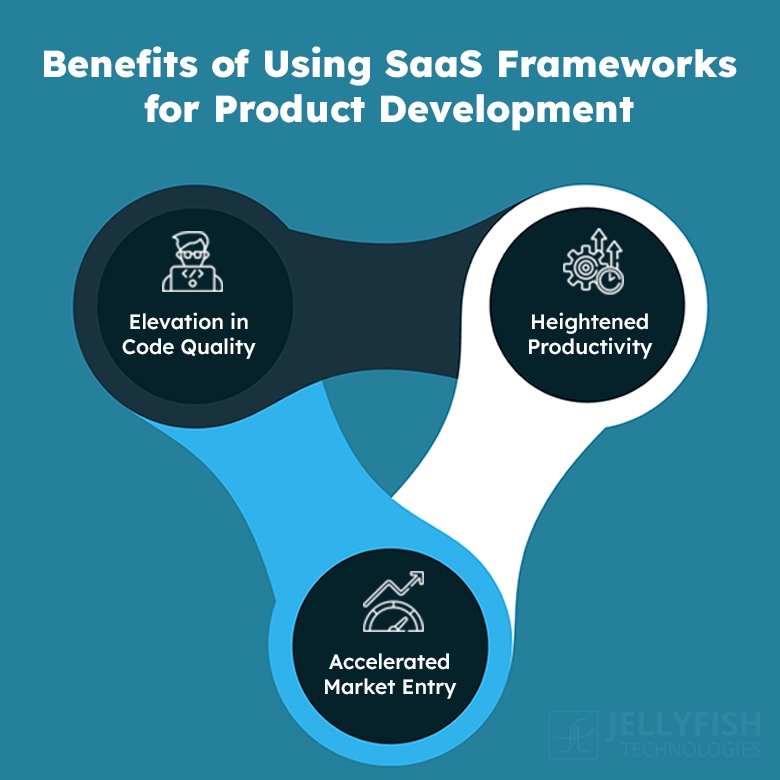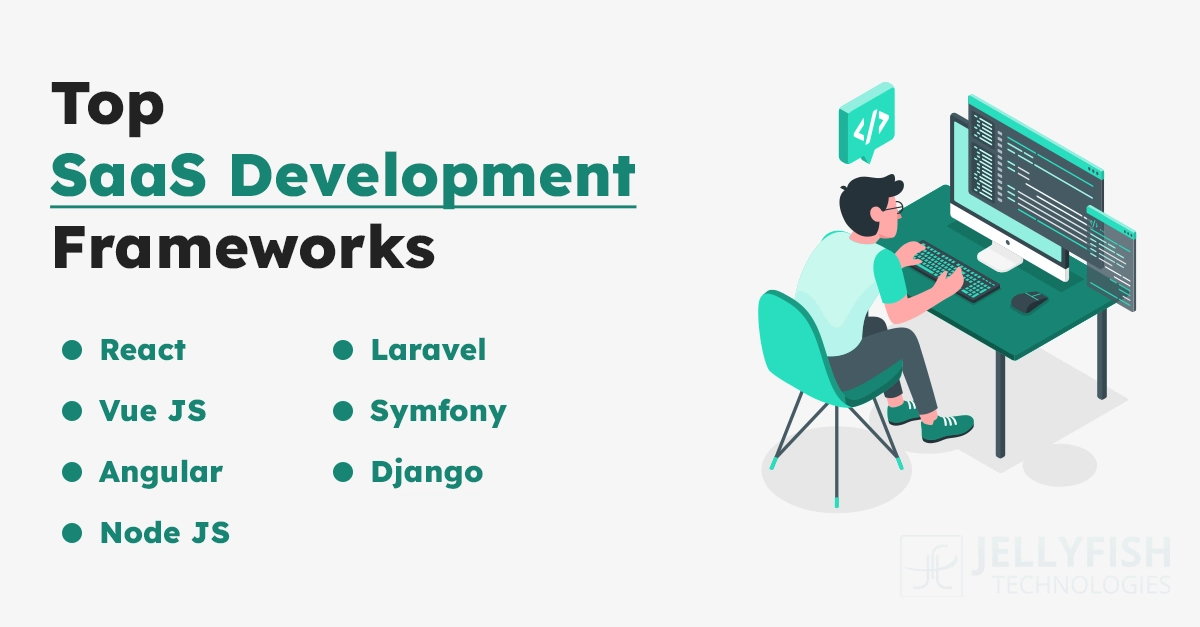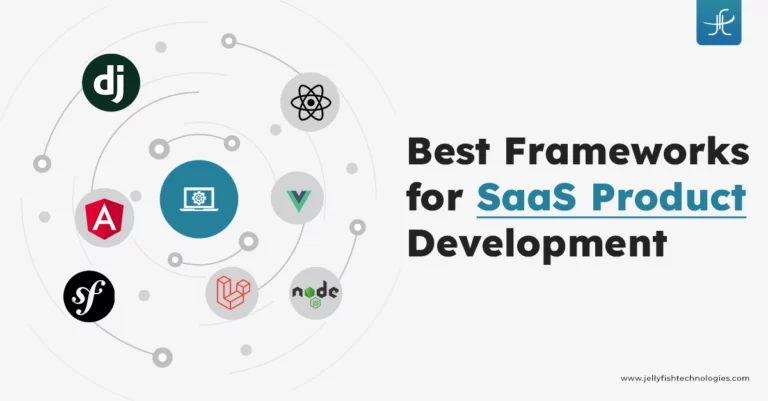Software-as-a-service (SaaS), has had a transformative impact on the technology landscape. Products such as Microsoft, Zoom, Hubspot, Google Workspace, Slack, and various others have commenced in this new era for businesses, fundamentally altering their modes of operation, communication, task management, and even the execution of large-scale global processes.
Given the plethora of SaaS products available in the market, the industry is projected to witness substantial growth, with end-user expenditures expected to reach $208 billion by the year 2023. It’s not only startups and small businesses; even larger software development companies are exploring various approaches to integrate Saas product management company solutions and dismantle their extensive monolithic applications.
Benefits of Using SaaS Frameworks for Product Development
Embark on a seamless product development journey with SaaS frameworks. Experience agility, scalability, and reduced costs allowing users to witness ideas materialize effortlessly while leveraging the power of innovative and user-friendly SaaS solutions.
Elevation in Code Quality
SaaS frameworks introduce an array of tools and functionalities that enhance the quality of code, thus contributing to an enhanced SaaS development process.
Heightened Productivity
SaaS frameworks come with established best practices and conventions, guiding developers in creating high-quality code. This not only reduces the likelihood of errors but also elevates the codebase’s ease of maintenance. They also offer a suite of automated tools and utilities that streamline repetitive tasks, such as testing and deployment.
Accelerated Market Entry
SaaS product development service frameworks include pre-configured modules and libraries, empowering developers to recycle code, and ultimately saving time and effort that would otherwise be spent constructing features from scratch.

Top 7 SaaS Development Frameworks
Explore the landscape of top SaaS development frameworks, where innovation meets efficiency. From robust scalability to seamless integration, these frameworks redefine the way applications are built, delivering unparalleled user experiences and business value.
React
For businesses looking to enhance their user interface and user experience of web and mobile SaaS applications, React is the best choice. With a market share of 4.2%, React is commonly employed by developers to construct expansive and adaptable web applications. By virtue of its Virtual DOM, React simplifies the manipulation of web pages, thereby improving the overall user interface interactions. Its primary focus revolves around delivering scalability and adaptability and can be seen in media platforms like Instagram, Facebook, and Netflix.
Key Features of React:
- Streamlines code maintenance by offering a multitude of reusable components.
- Enhances the speed and efficiency of rendering visual content, leading to faster processing.
- Simplifies the creation of search engine-optimized user interfaces.

Vue.js
Vue.js stands out as a versatile web development framework, empowering around 1.0% of developers to construct extensive applications using JavaScript and 1.6% of overall websites. Its reputation has soared due to its capacity for seamless integration into web applications and its user-friendly approach, which makes it highly accessible for web developers. Vue.js has served as the foundation for a wide array of robust applications, ranging from team collaboration tools and trading platforms.
Key Features of Vue.js:
- Facilitates the creation of templates for web applications by promoting the reuse of various components.
- Offers direct integration into applications without the need for additional external code.
- Enables users to store each component of a web application in separate files, enhancing code maintenance and overall readability.
Angular
Angular, a free framework developed by Google for front-end software development, empowers developers to create large-scale SaaS applications. It comes equipped with integrated tools that ensure a highly secure framework and facilitate two-way data binding, resulting in time savings and an efficient web development process. In addition to CSS and HTML, Angular utilizes Typescript, a programming language specifically designed to maintain code consistency. Angular offers a comprehensive suite of powerful tools for SaaS application development, including HTML, CSS, Typescript, Karma, Mocha, and Visual Studio. These resources significantly enhance the efficiency of the web development process and simplify program compilation due to which it shares a market share of 22.96%.
Key Features of Angular:
- Simplifies programming with MVC structure and two-way data binding.
- Provides a clear and well-organized coding structure that simplifies bug detection and error correction.
- Empower developers to create reusable and easily accessible code components.
Node.js
Node.js stands out as a superb framework for crafting network applications or systems that require swiftness and scalability. It proves particularly beneficial for processing and managing real-time data in scenarios involving multiple users. Node.js operates on the “Single Threaded Event Loop” architecture, a feature that empowers it to effectively handle multiple clients concurrently. This unique approach results in quicker task execution, minimizes thread usage, and conserves memory resulting in a usage of around 1.4% to 2.2%, totaling 30 million websites.
Key Features of Node.js:
- Offers rapid scalability and includes built-in clustering capabilities.
- Supports cross-platform development, making it versatile across various operating systems.
- Simplifies integration into full-stack development by using JavaScript throughout.
- Provides architectural flexibility, permitting changes in one node without disrupting the entire system’s operation.
Laravel
Laravel, a free and open-source framework developed with PHP, has played a pivotal role in the creation of over 140,000 websites spanning 98,260 domains. It adheres to the MVC (Model-View-Controller) architecture, encompassing a diverse range of templates and web applications meticulously crafted using PHP. As a dependable and advanced framework, Laravel stands out as an excellent choice for startups and emerging businesses. It simplifies data access and manipulation for developers through the implementation of object-relational mapping (ORM) and provides an extensive repository of pre-built functionalities and cutting-edge tools to expedite the SaaS development process.
Key Features of Laravel:
- Furnishes straightforward, pre-designed structures for developing layouts infused with dynamic content seeding.
- Elevates control over entry and authorization logic across various resources.
- Automates repetitive tasks through the utilization of the command-line tool, Artisan.
- Incorporates libraries crafted with object-oriented programming techniques.
Symfony
Symfony, a SaaS development framework embraced by an extensive community of nearly 600,000 developers across 100 countries and used in 80,554 websites, offers a robust architecture for the creation of SaaS applications. This highly popular framework comes equipped with a comprehensive array of features, encompassing templates, ORM, multiple libraries, data security, and unified modules. Symfony seamlessly integrates with independent libraries and PHP Units, showcasing its adaptability across a diverse range of applications, from powering eCommerce platforms and media services to streamlining operations in the travel industry and enhancing Content Management Systems.
Key Features of Symfony:
- Enhances security by providing robust protection against cross-site request forgery attacks.
- Simplifies navigation between website pages, ensuring a seamless experience devoid of errors or complications.
- Facilitates debugging with the aid of an extendable and customizable toolbar.
- Offers PHP components that can be reused multiple times and separately, promoting code efficiency and reusability.
Django
Django, a high-level Python web framework, empowers developers to rapidly construct resilient SaaS products. With a remarkable track record that includes over 80,000 websites, Django excels in the development of intricate, data-driven websites and the creation of first-rate web and Android applications. Its pragmatic product design, tailored for SaaS applications, expedites the development process, saving valuable time. Whether it’s Content Management Systems, event management platforms, or web browsers, Django’s adaptability and efficiency establish it as the preferred choice across diverse industries.
Key Features of Django:
- Streamlines the development of pre-built, user-friendly interfaces for efficient task management.
- Offers comprehensive app testing for heightened accuracy and reliability.
- Promotes straightforward data retrieval through the use of an object-oriented database.
SaaS Framework for Product Development?
When evaluating a software development framework, it’s essential to take into account elements such as cost efficiency, adaptable pricing structures, customization options, and automation capabilities. Additionally, a thorough analysis of its integration potential and how well it aligns with your specific requirements is crucial. Hence, the question arises: What criteria should you consider when seeking an appropriate SaaS development framework?
Programming Language
Selecting a framework that aligns with your team’s proficiency in a particular programming language is of utmost importance. The success of your application largely hinges on your developers’ skill set. For example, adopting a framework that employs an unfamiliar language could impede your team’s progress and necessitate the hiring of additional developers, ultimately driving up costs.
Security and Customer Support
SaaS frameworks offer an array of features to ensure data protection and enhance customer satisfaction. These encompass data encryption, two-factor authentication, role-based access control, routine audits, penetration testing, and compliance with industry standards and regulations. In terms of support, SaaS development frameworks may provide multiple customer support channels, including email, phone, or live chat, along with self-help resources like knowledge bases and community forums. They might also include service level agreements (SLAs) that guarantee uptime and response times, coupled with continuous monitoring and alerts for potential issues.
Scalability and Flexibility
While creating your SaaS application, it is essential to opt for a flexible framework that can readily accommodate updates and changes, keeping pace with evolving industry standards and your business’s growth. Remember that the chosen framework will likely be in use for five to ten years. Evaluating the framework’s scalability, both vertical and horizontal, becomes a critical consideration. A flexible framework supports seamless updates and the integration of additional tools as your business expands, ensuring your software remains current and adaptable to industry shifts.
Business Requirements
When selecting the most suitable framework for your business, it’s crucial to concentrate on your specific objectives rather than simply following popular trends. Seek out SaaS development frameworks equipped with comprehensive libraries and databases that align with your project’s unique requirements, as these attributes can significantly influence your technology stack selection.
SaaS Application Development Cost
In the process of choosing a SaaS application development company framework, it’s imperative to consider your budget and operate within the financial constraints of your organization. It’s not just the platform’s cost that should be taken into account; the functionality it offers should also be a central focus. This balanced approach can assist businesses in cost-effectively achieving high-quality results. The cost can range from $15,000 to $100,000. Customers can look within the average price between $50,000 – $60,000 or for a complex SaaS application ranging from $140,000-$150,000.
Conclusion
The anticipated global market size for SaaS-based solutions is projected to reach $307.3 billion by 2026, signifying that the SaaS sector’s potential for growth will continue to maintain a dominant position well into 2023 and beyond. Software as a Service (SaaS) stands out as one of the swiftest emerging models within the IT industry. As businesses increasingly transition to cloud-based software solutions, SaaS product development services enjoy a prominent lead over other cloud services. By harnessing SaaS, businesses can circumvent the need for substantial investments in costly software or hardware for product development, thanks to its seamless accessibility via the cloud through web browsers.
Shifting a substantial portion of business operations to SaaS development, software development services offer several advantages, including enhanced scalability, heightened security, improved reliability, and cost savings for IT teams. Beyond the benefits realized by product teams, project managers, and development executives, custom Saas product Development company offering frameworks have become appealing even to tech industry giants such as Microsoft, Oracle, IBM, and SAP. Consequently, given this wealth of information, businesses must make well-informed decisions regarding the optimal utilization of SaaS frameworks.



